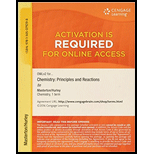
CHEMISTRY:PRIN.+REACTIONS-OWLV2 ACCESS
8th Edition
ISBN: 9781305079298
Author: Masterton
Publisher: Cengage Learning
expand_more
expand_more
format_list_bulleted
Concept explainers
Textbook Question
Chapter 23, Problem 45QAP
Describe what is meant by
(a) the primary structure of a protein.
(b) the secondary structure of a protein.
(c) the tertiary structure of a protein.
Expert Solution & Answer
Want to see the full answer?
Check out a sample textbook solution
Students have asked these similar questions
Correctly name this compound using the IUPAC naming system by sorting the
components into the correct order.
Br
IN
Ν
H
How is the radical intermediate for this structure formed? Can you please draw arrows from the first radical to the resonance form that would result in this product? I'm lost.
Part VI.
(a) calculate the λ max of the compound using woodward - Fieser rules.
(b) what types of electronic transitions are present in the compound?
(c) what are the prominent peaks in the IR spectrum of the compound?
Chapter 23 Solutions
CHEMISTRY:PRIN.+REACTIONS-OWLV2 ACCESS
Ch. 23 - Prob. 1QAPCh. 23 - Prob. 2QAPCh. 23 - Prob. 3QAPCh. 23 - Prob. 4QAPCh. 23 - Prob. 5QAPCh. 23 - Prob. 6QAPCh. 23 - Prob. 7QAPCh. 23 - Prob. 8QAPCh. 23 - Prob. 9QAPCh. 23 - Prob. 10QAP
Ch. 23 - Prob. 11QAPCh. 23 - Prob. 12QAPCh. 23 - Prob. 13QAPCh. 23 - Prob. 14QAPCh. 23 - Prob. 15QAPCh. 23 - Prob. 16QAPCh. 23 - Prob. 17QAPCh. 23 - Prob. 18QAPCh. 23 - Prob. 19QAPCh. 23 - Prob. 20QAPCh. 23 - How many chiral carbon atoms are there in ...Ch. 23 - How many chiral carbon atoms are there in sucrose?...Ch. 23 - Prob. 23QAPCh. 23 - Give the structural formulas of two different...Ch. 23 - (a) How many tripeptides can be made from glycine,...Ch. 23 - Prob. 26QAPCh. 23 - Prob. 27QAPCh. 23 - Prob. 28QAPCh. 23 - For alanine, Ka1=5.1105,Ka2=1.81010 . Calculate...Ch. 23 - Prob. 30QAPCh. 23 - On complete hydrolysis, a polypeptide gives two...Ch. 23 - Prob. 32QAPCh. 23 - Prob. 33QAPCh. 23 - Prob. 34QAPCh. 23 - Prob. 35QAPCh. 23 - Prob. 36QAPCh. 23 - Prob. 37QAPCh. 23 - Prob. 38QAPCh. 23 - Prob. 39QAPCh. 23 - Prob. 40QAPCh. 23 - Prob. 41QAPCh. 23 - Sketch the form in which leucine would exist in...Ch. 23 - How many tripeptides could one make from glycine,...Ch. 23 - A 1.00-mg sample of a pure protein yielded on...Ch. 23 - Describe what is meant by (a) the primary...Ch. 23 - Glycolysis is the process by which glucose is...Ch. 23 - Plants synthesize carbohydrates from CO2 and H2O...Ch. 23 - Prob. 48QAPCh. 23 - Prob. 49QAPCh. 23 - Prob. 50QAPCh. 23 - Prob. 51QAPCh. 23 - Aspartic acid acts as a triprotic acid with...
Knowledge Booster
Learn more about
Need a deep-dive on the concept behind this application? Look no further. Learn more about this topic, chemistry and related others by exploring similar questions and additional content below.Similar questions
- Don't used Ai solutionarrow_forwardPlease correct answer and don't used hand raitingarrow_forward↑ 0 Quiz List - RCC430M_RU05 X Aktiv Learning App × Qdraw resonance structure ×Q draw resonance structure xb My Questions | bartleby ×+ https://app.aktiv.com Draw a resonance structure of pyrrole that has the same number of pi bonds as the original structure. Include all lone pairs in your structure. + N H a 5 19°F Cloudy Q Search Problem 12 of 15 Atoms, Bonds and Rings Charges and Lone Pairs myhp हजु Undo Reset Remove Done Submit Drag To Pan 2:15 PM 1/25/2025arrow_forward
- Briefly indicate the structure and bonding of silicates.arrow_forward4 Part C Give the IUPAC name and a common name for the following ether: Spell out the full names of the compound in the indicated order separated by a comma.arrow_forwardTry: Draw possible resonance contributing structures for the following organic species: CH3CH2NO2 [CH2CHCH2] [CH2CHCHO] [CH2CHCH2] [CH2CHNH2]arrow_forward
arrow_back_ios
SEE MORE QUESTIONS
arrow_forward_ios
Recommended textbooks for you
 General, Organic, and Biological ChemistryChemistryISBN:9781285853918Author:H. Stephen StokerPublisher:Cengage Learning
General, Organic, and Biological ChemistryChemistryISBN:9781285853918Author:H. Stephen StokerPublisher:Cengage Learning Organic And Biological ChemistryChemistryISBN:9781305081079Author:STOKER, H. Stephen (howard Stephen)Publisher:Cengage Learning,
Organic And Biological ChemistryChemistryISBN:9781305081079Author:STOKER, H. Stephen (howard Stephen)Publisher:Cengage Learning, World of Chemistry, 3rd editionChemistryISBN:9781133109655Author:Steven S. Zumdahl, Susan L. Zumdahl, Donald J. DeCostePublisher:Brooks / Cole / Cengage Learning
World of Chemistry, 3rd editionChemistryISBN:9781133109655Author:Steven S. Zumdahl, Susan L. Zumdahl, Donald J. DeCostePublisher:Brooks / Cole / Cengage Learning World of ChemistryChemistryISBN:9780618562763Author:Steven S. ZumdahlPublisher:Houghton Mifflin College Div
World of ChemistryChemistryISBN:9780618562763Author:Steven S. ZumdahlPublisher:Houghton Mifflin College Div Introductory Chemistry: A FoundationChemistryISBN:9781337399425Author:Steven S. Zumdahl, Donald J. DeCostePublisher:Cengage Learning
Introductory Chemistry: A FoundationChemistryISBN:9781337399425Author:Steven S. Zumdahl, Donald J. DeCostePublisher:Cengage Learning ChemistryChemistryISBN:9781305957404Author:Steven S. Zumdahl, Susan A. Zumdahl, Donald J. DeCostePublisher:Cengage Learning
ChemistryChemistryISBN:9781305957404Author:Steven S. Zumdahl, Susan A. Zumdahl, Donald J. DeCostePublisher:Cengage Learning

General, Organic, and Biological Chemistry
Chemistry
ISBN:9781285853918
Author:H. Stephen Stoker
Publisher:Cengage Learning

Organic And Biological Chemistry
Chemistry
ISBN:9781305081079
Author:STOKER, H. Stephen (howard Stephen)
Publisher:Cengage Learning,

World of Chemistry, 3rd edition
Chemistry
ISBN:9781133109655
Author:Steven S. Zumdahl, Susan L. Zumdahl, Donald J. DeCoste
Publisher:Brooks / Cole / Cengage Learning

World of Chemistry
Chemistry
ISBN:9780618562763
Author:Steven S. Zumdahl
Publisher:Houghton Mifflin College Div

Introductory Chemistry: A Foundation
Chemistry
ISBN:9781337399425
Author:Steven S. Zumdahl, Donald J. DeCoste
Publisher:Cengage Learning

Chemistry
Chemistry
ISBN:9781305957404
Author:Steven S. Zumdahl, Susan A. Zumdahl, Donald J. DeCoste
Publisher:Cengage Learning
Biomolecules - Protein - Amino acids; Author: Tutorials Point (India) Ltd.;https://www.youtube.com/watch?v=ySNVPDHJ0ek;License: Standard YouTube License, CC-BY